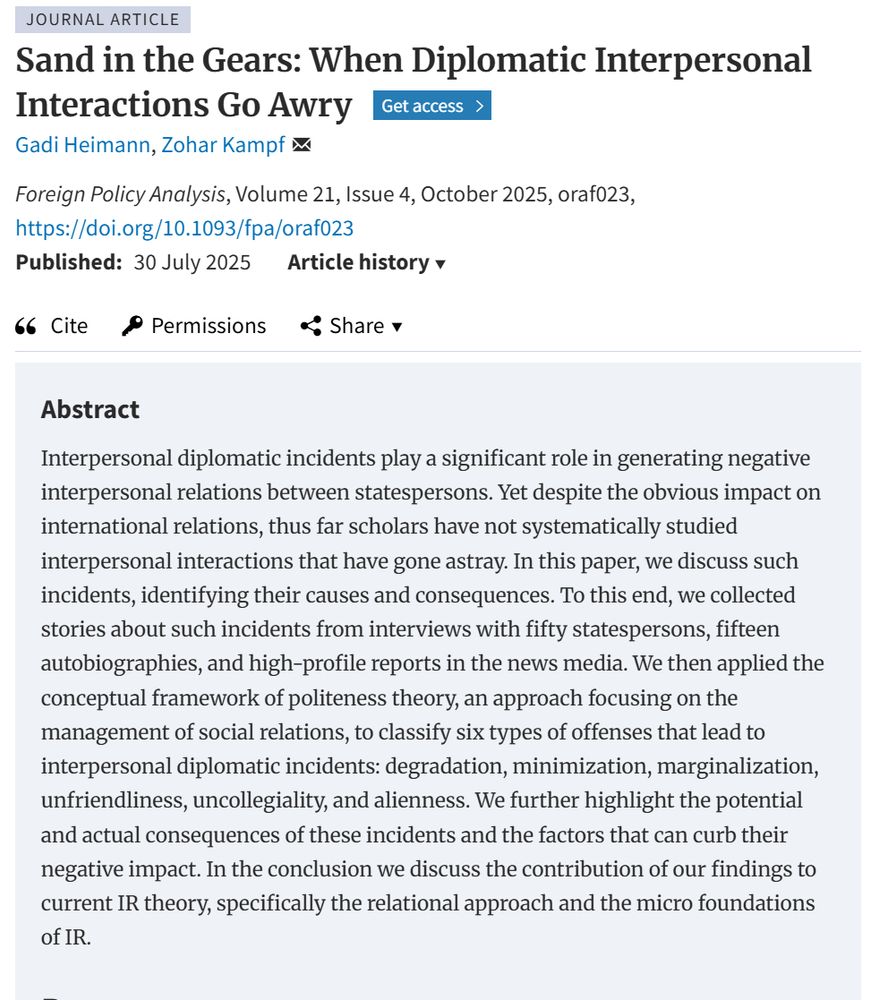
Pipoyan and Meibauer (2025) show that Armenia’s limited hedging toward Russia stemmed from systemic constraints and pragmatic elite ideas, producing selective bandwagoning and partial balancing.
academic.oup.com/fpa/article/...
@fpajrnl.bsky.social
Foreign Policy Analysis - An International Studies Association (ISA) Journal Editors-in-Chief: Brian Lai & Lisbeth Aggestam

Pipoyan and Meibauer (2025) show that Armenia’s limited hedging toward Russia stemmed from systemic constraints and pragmatic elite ideas, producing selective bandwagoning and partial balancing.
academic.oup.com/fpa/article/...

Imanishi (2025) shows that both the volume and diversity of media coverage shape U.S. bureaucratic responsiveness in complex emergency aid between 2000 and 2019.
academic.oup.com/fpa/article/...

Visoka and Brajshori (2025) show that aspirant states like Kosovo use protean power—adaptability, innovation, and improvisation—to navigate barriers to recognition and gain partial legitimacy in international organizations. academic.oup.com/fpa/article/...
30.09.2025 17:54 — 👍 3 🔁 2 💬 0 📌 0
Wang and Xiang (2025) find that bilateral investment treaties boost foreign aid flows by compensating or enforcing compliance, with democracies favoring compensation and autocracies enforcement.
academic.oup.com/fpa/article/...

🚨NEW ARTICLE🚨
Abu-Haltam (2025) shows that Jordan practices “indirect bandwagoning,” subtly aligning with U.S. interests by limiting China’s influence without open confrontation, illustrating how aid-dependent states navigate great power rivalry.
academic.oup.com/fpa/article/...

Dörfler (2025) explains Russia’s invasion of Ukraine by showing how groupthink amplified loss-framed risk perceptions among Putin’s inner circle, making high-risk behavior more likely and frame reversal improbable.
academic.oup.com/fpa/article-...

Choi (2025) finds that security alliances significantly reduce the likelihood of war, providing strong support for deterrence theory over the Steps-to-War perspective.
academic.oup.com/fpa/article/...

Heimann and Kampf (2025) show that interpersonal diplomatic offenses such as degradation, unfriendliness, and marginalization disrupt relations between state representatives and call for their systematic study in IR.
academic.oup.com/fpa/article-...

🚨NEW ARTICLE🚨
Girard and Wilhelm (2025) find Americans oppose data localization when framed as costly, with attitudes shaped more by ethnocentrism than geopolitics.
academic.oup.com/fpa/article/...
@alex-wilhelm.bsky.social @tylergirard.bsky.social

Asadzade (2025) shows, survey data from Iran before and during the 2024 Iran–Israel confrontation reveal a sharp rise in support for nuclear weapons, driven mainly by security concerns and deterrence needs.
academic.oup.com/fpa/article/...

Do small states under hegemonic pressure always choose between balancing or bandwagoning?
Pipoyan and Meibauer (2025) show that Armenia instead pursued a form of limited hedging shaped by Russian assertiveness and domestic ideas.
academic.oup.com/fpa/article/...

Does leadership turnover in recipient states reduce arms orders from previous suppliers? Mehrl (2025) finds no empirical evidence that it does.
academic.oup.com/fpa/article/...

🚨NEW ARTICLE🚨
Risse (2025) shows that democracies consistently support conventional arms control but back nuclear arms control only when resolutions are co-sponsored by other democracies.
academic.oup.com/fpa/article/...

Choi (2025) finds strong empirical support for deterrence theory over Steps-to-War theory by showing that alliances significantly reduce the likelihood of war, the most destructive form of conflict.
academic.oup.com/fpa/article/...

Heimann and Kampf (2025) examine how interpersonal diplomatic offenses, such as degradation and marginalization, disrupt state relations and call for integrating these micro-level interactions into International Relations theory.
academic.oup.com/fpa/article/...

Imanishi (2025) shows that U.S. emergency aid increases not just with media volume, but especially when coverage is diverse in framing—revealing that “attention diversity” significantly shapes bureaucratic responsiveness.
academic.oup.com/fpa/article-...

Jenichen and Deka (2025) show that focusing solely on religion—without accounting for class and gender—limits the effectiveness of FoRB advocacy, as illustrated by the Asia Bibi case in Pakistan.
academic.oup.com/fpa/article/...

Flowers (2025) introduces the HEX dataset to analyze global espionage exposures, revealing that most accused spies were state personnel motivated by money across 483 cases from 1946 to 2010.
academic.oup.com/fpa/article-...

Fracalossi de Moraes (2025) shows that perceived adjustment costs were key, APMs were seen as low-cost to abandon, while cluster munitions posed significant material burdens.
academic.oup.com/fpa/article/...

LaSpisa and Mitchell (2025) find that democratic dyads are more prone to maritime conflict due to stronger domestic interests, executive constraints, and weaker territorial norms at sea.
academic.oup.com/fpa/article/...

🚨NEW ARTICLE🚨
Zvobgo and Simmons (2025) show that most Americans still support ICC war crimes investigations, even when U.S. personnel are targeted, though national interest arguments can dampen this support.
academic.oup.com/fpa/article/...

🚨NEW ARTICLE🚨
Attia (2025) shows that U.S. presidents with strong party support and high approval are more likely to lift sanctions, while congressional oversight makes termination less likely and slower.
academic.oup.com/fpa/article/...

Cadier (2024) shows that populist governments politicize foreign policy by opposing predecessors and using external affairs to advance domestic battles, as illustrated by Poland’s case.
academic.oup.com/fpa/article/...

Thiers (2024) shows that Evo Morales’s shifting emotions toward Chile help explain why Bolivia’s foreign policy oscillated between cooperation and escalation in their long-standing rivalry.
academic.oup.com/fpa/article/...

Gloria (2025) shows that Duterte's foreign policy pivot toward China and away from the U.S. was shaped by a populist discourse of national victimhood, framing the Philippines as historically wronged and insecure in a shifting global order.
academic.oup.com/fpa/article-...

Abbasov and Thies (2023) show that in Armenia, Azerbaijan, and Georgia, individuals with stronger pro-democracy attitudes are more likely to support a pro-Western foreign policy over alignment with Russia.
academic.oup.com/fpa/article/...

How does the lack of intersectionality limit international religious freedom policies?
academic.oup.com/fpa/article/...

Cadier (2024) argues that populist governments politicize foreign policy by opposing predecessors, instrumentalizing diplomacy for domestic battles, and prioritizing internal political incentives over external strategic logic.
academic.oup.com/fpa/article/...

Oestman and Passmore (2024) show that while leadership change often disrupts peacekeeping contributions, democracies maintain more consistent commitments due to institutional constraints and overlapping domestic preferences.
academic.oup.com/fpa/article/...

How do publics respond to coercive vs. persuasive foreign messaging? Davies, Edney, and Williams (2025) find that even mild persuasive messages from China on UK nuclear investment backfired—security threat perceptions consistently fueled public resistance.
academic.oup.com/fpa/article/...